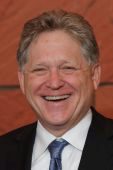This paper builds on our earlier work, Meltzer and Richard (1981), on the size of government. How does the distribution of income changes as an economy grows? To answer this question we build a model of a labor economy in which consumers have diverse productivity. The government imposes a linear income tax which funds equal per capita redistribution. The tax rate is set in a single issue election in which the median productivity individual is decisive. Economic growth is the result of using a learning by doing technology, so higher taxes discourage labor causing the growth rate of the economy to fall. We consider two economic scenarios. First, in a developing economy the median voter chooses increasing taxes and increasing redistribution which causes the growth rate of the economy to recede from a high level as the economy matures. The increasing tax rate discourages labor and growth causing the distribution of pre-tax income to widen. Second, in a mature economy, the distribution of productivity can widen due to increased technological specialization. This causes voters to raise the equilibrium tax rate and reduce growth. The distribution of pre-tax income widens. We estimate the model using U.S. data from 1967 – 2011 with excellent results.
Scott F Richard

Contact Information
- Primary Email:
scottri@wharton.upenn.edu - Office Phone:
(215) 898-3004
- office Address:
3257 Steinberg-Dietrich Hall
3620 Locust Walk
Philadelphia, PA 19104
Research Interests: asset pricing and the macro-economy.the term structure of interest rates.the global bond market., growth of government
Links: CV
Activity
Latest Research
Allan H Meltzer and Scott F Richard (Draft), A Positive Theory of Economic Growth and the Distrbution of Income.
All ResearchIn the News
What’s Behind the Endless Breakup-Merger Cycle?Ferrero’s acquisition of WK Kellogg is the latest in the breakup-merger cycle among consumer packaged goods firms. Wharton’s Emilie Feldman explains why it won’t be the last.…Read More
Knowledge @ Wharton - 2025/09/16

